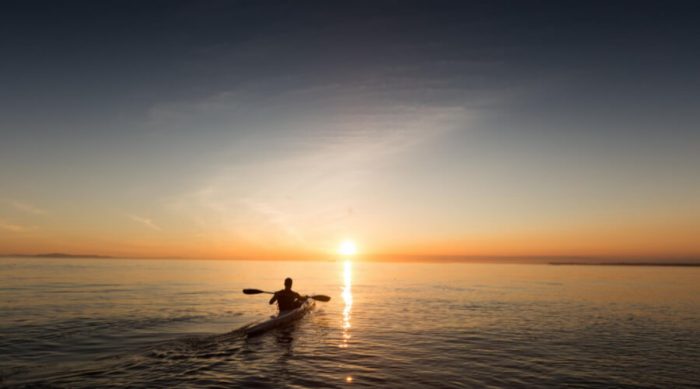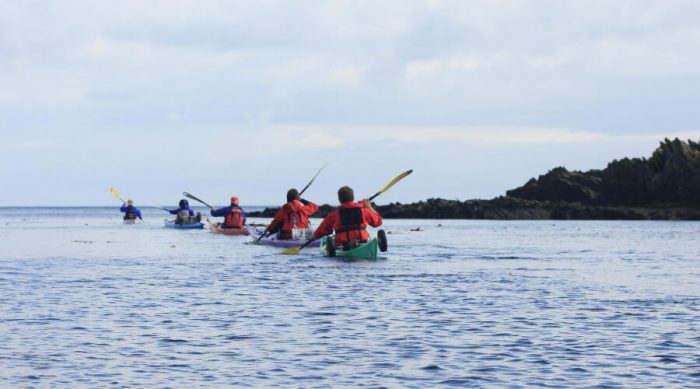Kayaking is an adventurous and thrilling activity that makes paddlers want to take the adventure to the next level, which is longer and riskier. However, crossing the Pacific is next to an impossible mission even for experienced paddlers.
Key Takeaways
- Ed Gillet is the 1st man to ever cross the Pacific Ocean and he did it in 1987 when he was 36 years old
- Ed Gillet paddled from Monterey bay to Maui, covering almost 2500 miles in 64 days
- Some of the common reasons that make kayak across the Pacific Ocean challenging are food, water, waves, weather condition, etc.
Who Has Managed?
Several people have tried kayaking across the Pacific Ocean and have not managed to do it. Most give up as soon as they start when they are still on day one or week 1 for those who try to persevere. Kayaking across the Pacific comes with several risks, and only one has managed to do it.
The first man to ever cross the Pacific Ocean is called Ed Gillet. He kayaked across the Pacific Ocean in 1987, when he was just 36 years old. He left his newly wedded wife behind, an experienced kayaker, to venture into the unknown. In search of solitude and calmness, the then 36-year-old chose to go across the Pacific. Gillet almost gave up on the eighth day when he turned his kayak back to where he was coming but convinced himself to continue with the journey he had started. He paddled from Monterey bay to Maui, covering almost 2500 miles in 64 days. Even though he had anticipated traveling in about 49 weeks, nature did not allow him to do that as he paddled another two weeks before he saw a sign of dry land.
He encountered several challenges; he lost communication with his family just nine days after starting his journey. He did not know this and thought that the family would be present when he reached dry land, only to find that no one was waiting for him. He also encountered seasickness, stormy seas, lack of sleep, and saltwater sores. He ran out of food and survived on toothpaste for about four days before landing. Even though he got across the Pacific, the challenges he experienced, only a few could manage to survive for all those days and endure.
Why Is It Challenging To Kayak Across The Pacific Ocean?

It’s challenging to kayak across the Pacific Ocean, and any attempt to cross this ocean using a kayak will pose a threat to your life. Below are the reasons that make it challenging to kayak across the Pacific Ocean;
1. Food
Food is an essential component that is much needed for the survival of human beings and any living creature. Therefore, you will need to carry food before traveling across the ocean, which may be impossible. For example, from Google maps, the distance between the USA to Japan via Hawaii is 2,756 miles. If you are an average kayaker, you will kayak at an average speed of 5mph, which means that you will have to travel for 551 hours, equivalent to 23 days. It will require you to carry food that you will survive on for those 23 days. American travelers will have to take 89,537 calories or 92.7 Big Mac meals which will be difficult given that a kayak can only accommodate about 20 Big Mac Meals.
2. Water
If you don’t take water for more than three days, you can die. In the Pacific Ocean, there is a lot of water, but it’s salt water, of which if you take much of it, you’ll also die. For you to drink that water, it will be required to be desalinated. You will have to either attach a salt removal plant to your kayak, which is impossible because your kayak will sink even before you take off. You can also use iodine, which means you will have to leave behind some of the vital meals to be carried for your survival. When the ocean is bumpy, it will even cause more problems to desalt because of paddling difficulties in such a situation. If much care is not taken, you will possibly fail.
3. Sharks
It’s challenging to get sharks even in dangerous rapids, but expect attacks from the sharks when traveling across the Pacific Ocean. Out of 440 species of sharks found in the world, approximately 36 species are found in the Pacific Ocean, including the Great White Shark. According to stats, 20% of shark attacks worldwide are done by Great White Sharks, including attacks on kayakers.
4. Tankers
These are the big ships that may not even see you or may not be interested in small-fry like you in your paddle because most of them are on auto-pilot mode when the captain is having a snooze. In case it happens that you also have a snooze at the same time, then you will be crashed. Even if you survive, nobody will hear you when you shout ‘Tanker.’ Hence, it requires maximum attention and a lot of care to avoid such accidents. Consider wearing visible and bright color attire so that you can be spotted from a distance.
5. Waves
The Pacific Ocean sometimes experiences sudden waves that may hit your kayak. This may cause death, as your kayak will capsize. Or the iodine you carried on your kayak may fall off into the water and desalinate it. As a result, numerous aquatic creatures that live in saltwater, such as fish, will die because they can’t survive in non-saltwater. This will cause an imbalance in the flow of energy.
6. No Land Nearby
Oceans, including the Pacific Ocean, are unpredictable and rough weather keeps on changing anytime. The weather can abruptly change from sunny to extreme cold. You will be required to have a stoppage to adjust to the surrounding weather before continuing with your journey. Also, paddling for a long time will cause general tiredness of the body; therefore, it’ll be necessary to rest, relax and refresh yourself in proceeding with your journey. Given that there is no nearby land in the Pacific Ocean, your body will get fatigued and fail to withstand this situation, which may result in accidents associated with water and cause death.
7. Hypothermia
The ocean water may be cold, making your body have abnormally low temperatures and failing to generate the heat energy required. This will lead to sickness and failure to paddle due to the freezing condition of the body. It will make it easy for your kayak to capsize if the strong wind or rough waves get you in such a condition.
Precautions Before Heading Out To Sea

Before you decide whether or not you should kayak deep waters or even try to cross the Pacific, you must consider these factors. When going out to kayak for several days in a row, you need to take several precautions.
1. When packing for your essentials, food and water are among them. Ensure that you pack food and water that can last you as many days as you plan to be at sea. Nutrition bars will give you energy, and you can pack a lot because they have less volume. You should check out the weight capacity of your kayak to ensure that you don’t exceed it because you don’t want to capsize in deep water.
2. Put your safety at the forefront of the matter. Ensure that you have all the necessary equipment for your safety, starting from a reflector, ensuring your kayak is bright enough, and a floater. It would help if you also took a radio and whistle, compass, and first aid kit with you.
3. Discomfort is among the last things you want when going out, so make sure your kayak seat is well-padded with a backrest. You may also carry a hat to provide some shade during sunny days.
4. Ensure that you check the weather conditions. Who wants to head out to sea on a stormy night in a kayak anyway? Calm is what you need at such a time. A sit-in kayak will ensure you are dry. An extra pair or two of clothes will come in handy in case you get wet.
5. Learn ocean kayaking tips first before setting out to the deep sea. Do not risk too much. Ensure that you know what you will be doing.
Conclusion
We hope that you have your questions answered with reasons. We have also given you some tips if you want to head out kayaking in the deep sea. When you choose to take on such adventurous hobbies, you have to put your safety first.
References:
- https://www.quora.com/Is-it-possible-to-go-across-the-Pacific-ocean-in-a-kayak
- https://www.independent.co.uk/news/world/americas/kayaker-solo-hawaii-cyril-derreumaux-b1861494.html
- https://7reasons.org/2010/11/10/7-reasons-you-should-not-kayak-across-the-pacific-ocean

Rockey is a kayaking enthusiast who has been kayaking with a local group for the last five years. He loves using kayaks while out on outings on the water or camping when the friends want to have a BBQ party somewhere on the bank of a local lake. More About James R Rockey at About Page Here: Authors
Based on his experiences with the different types of kayaks, he is sharing his opinion about kayaking tricks and required gears so that a beginner can get started right away.
Find his team on Twitter here. Happy reading!
